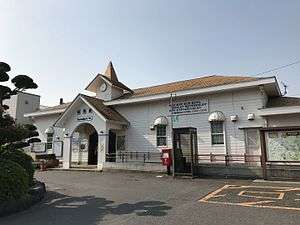Sasaguri Station
Sasaguri Station (篠栗駅, Sasaguri-eki) is a train station in Sasaguri, Fukuoka Prefecture, Japan. It is operated by Kyushu Railway Company (JR Kyushu).
Sasaguri Station 篠栗駅 | |
|---|---|
 | |
| Location | Sasaguri, Kasuya, Fukuoka Japan |
| Operated by | JR Kyushu |
| Line(s) | |
| History | |
| Opened | 1904 |
| Traffic | |
| Passengers (FY2016) | 4,786 daily |
| Rank | 43rd (among JR Kyushu stations) |
| Location | |
 Sasaguri Station Location within Japan | |
Lines
- JR Kyushu
Layout
It is a ground level station with two platforms and three tracks.
Tracks
| 1 | ■Sasaguri Line(Fukuhoku Yutaka Line) | for Hakata |
| 2 | ■Sasaguri Line(Fukuhoku Yutaka Line) | for Keisen,Shin-Iizuka,Nōgata and Orio |
| 3 | ■Sasaguri Line(Fukuhoku Yutaka Line) | for Hakata(The train that this station is the starting station) |
Adjacent stations
| ← | Service | → | ||
|---|---|---|---|---|
| Sasaguri Line (Fukuhoku Yutaka Line) | ||||
| Chikuzen-Yamate | Local | Kadomatsu | ||
| Kido-Nanzōin-mae | Rapid Service | Chōjabaru | ||
History
History
The station was opened on 19 June 1904 by the privately run Kyushu Railway as the eastern terminus of a stretch of track from Yoshizuka. When the Kyushu Railway was nationalized on 1 July 1907, Japanese Government Railways (JGR) took over control of the station. On 12 October 1909, the station became part of the Sasaguri Line. On 25 May 1968, Sasaguri became a through-station when the Sasaguri Line was extended further eat to Keisen. With the privatization of Japanese National Railways (JNR), the successor of JGR, on 1 April 1987, JR Kyushu took over control of the station.[1][2]
Passenger statistics
In fiscal 2016, the station was used by an average of 4,786 passengers daily (boarding passengers only), and it ranked 43rd among the busiest stations of JR Kyushu.[3]
External links
- Sasaguri Station (JR Kyushu) (in Japanese)
References
- Ishino, Tetsu; et al., eds. (1998). 停車場変遷大事典 国鉄・JR編 [Station Transition Directory - JNR/JR] (in Japanese). I. Tokyo: JTB Corporation. p. 221. ISBN 4533029809.
- Ishino, Tetsu; et al., eds. (1998). 停車場変遷大事典 国鉄・JR編 [Station Transition Directory - JNR/JR] (in Japanese). II. Tokyo: JTB Corporation. p. 697. ISBN 4533029809.
- "駅別乗車人員上位300駅(平成28年度)" [Passengers embarking by station - Top 300 stations (Fiscal 2016)] (PDF). JR Kyushu. 31 July 2017. Retrieved 25 February 2018.
| Wikimedia Commons has media related to Sasaguri Station. |